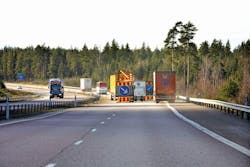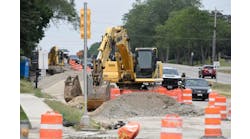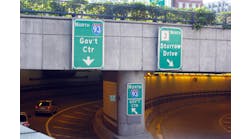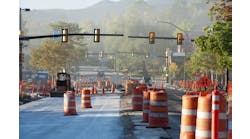Road maintenance can be used as a means to get more energy-efficient road transports, leading to an overall reduction of both the energy needed and emissions of greenhouse gases.
There is evidence that by choosing a maintenance option, which in itself is less energy efficient compared to other alternatives, it is possible to reduce the overall energy consumption of a road link. The result is dependent on the traffic volume and how much the rolling resistance can be improved.
Transport energy use amounts to approximately 30% of total energy use in Sweden. Road transport is responsible for a large part of this, more than 80%, and since mainly fossil fuels are used, road transport also is a large source of emissions of greenhouse gases. Therefore, it is a forthright development that the focus on climate change has led to attention on actions to reduce greenhouse-gas (GHG) emissions from road transport in order to mitigate global warming. Main efforts to reduce fuel use and also emission of carbon dioxide have so far mainly targeted development of alternative fuels, more fuel-efficient vehicles and a transfer of travels from passenger cars to more energy-efficient alternatives. However, in recent years more attention has been turned to road maintenance and how it can be used in order to reduce both total energy use and emissions of greenhouse gases. This could be achieved by choosing
a maintenance option that influences the road surface characteristics in order to gain a more favorable rolling resistance.
Roll with it
A cooperative was formed in 2010 between representatives from road authorities and research institutes in Europe and the U.S. The overall objective with MIRIAM (Models for Rolling Resistance In Road Infrastructure Asset Management Systems) is to “provide a sustainable and more environmentally friendly road infrastructure by developing an integrated methodology for improved control of road transport CO2 emissions.”
Within the cooperative, rolling resistance and the potential to make road transport more energy efficient comprises studies regarding measurement methods and surface properties modelling, the influence of pavement characteristics on energy efficiency and investigating the importance of rolling resistance on energy efficiency within an LCA framework.
As part of this cooperative, a study has been undertaken to look into the possibilities of reducing total energy use, including road traffic and pavement maintenance, by influencing the unevenness and macro texture of the road surface. The approach has been a life-cycle perspective, where actions and activities undertaken during a typical year are accounted for. Energy used by traffic is dependent on a great number of parameters constantly changing with climate, pavement deterioration and driver behavior. Vehicles in ideal constant-speed conditions expend energy due to wind drag, transmission losses and rolling resistance. Rolling resistance is, in turn, dependent on parameters such as vehicle rolling friction, tire losses, tire-surface interaction (macro texture), damping losses in suspensions (evenness) and losses due to precipitation (water and snow) present on the pavement surface. Road managers can influence several of these parameters, but at the cost of more or less energy use due to the actions and measures taken.
Giving three alternatives
Two case studies were performed in which the energy use for traffic- and pavement-management-induced actions were investigated in detail. The cases were a 1-km road section of a highway and a rural two-lane road, situated in the south of Sweden. Three different maintenance alternatives were defined for each road section, and based on what was believed appropriate for the specific roads. Resource needs for each maintenance alternative were calculated, based on technical specifications, experience of maintenance scenarios and case-specific conditions. Also, a qualified estimation of the development of both unevenness and macro texture was made, describing the expected values after the maintenance and how it would develop each year until it was time for a new maintenance measure. Traffic energy use was estimated using a vehicle energy simulation tool where the values of the road surface were taken into consideration. The sum of energy use due to maintenance and energy give total energy use for each of the alternative options. The result showed a total energy use per year and per km for each of the maintenance alternatives. According to the findings, traffic energy is, by far, the most important part of the energy use in the life cycle of a road. In these case studies the share was between 97.5% to 99.7% of total energy use. The difference in total energy use between the option with the lowest total energy use compared to the one leading to the highest total energy use was, however, pretty small—0.4% for the highway and 2% for the two-lane road where the savings of choosing the least energy-consuming alternative would lead to savings amounting to 76 GJ/year per km on the highway and 100 GJ/year per km on the two-lane road. More energy could be saved at the two-lane road even though the traffic volume was substantially smaller compared to the highway. The reason is a greater potential to improve road surface characteristics on this road due to the relatively poor initial conditions. The quality of the highway was already good and the improvements did not differ much between the alternative maintenance options.
In these case studies, the focus was on finding the alternative that was most energy efficient. However, road authorities have the task to keep widespread road networks in acceptable condition and at the same time deal with budget constraints. To rehabilitate a road section and to lower unevenness and macro texture will benefit energy efficiency, but it could also mean that the cost of doing so is high. Therefore, the road authority needs to consider the “best value for the money,” and hence spend their resources on road objects where they can get the largest reduction of total energy spent per dollar. Another aspect to consider is the level of uncertainty in the estimations. The value of using calculations of energy and costs as the basis for decision making is only as good as the accuracy of the input data. Since it is mainly information about future conditions, there is a level of uncertainty that one has to consider. The uncertainty can be found for all factors, such as costs, the characteristics of the road surface conditions after a treatment, the development of variables describing the road, the durability of the pavement and the energy use of traffic.
A meaningful instrument that enables a better consideration of maintenance cost and the total energy used when managing the road network could be a useful tool for road authorities in decision-making situations—for instance, when selecting and designing maintenance treatments. A general criterion called CR (cost ratio) using a benefit-to-cost ratio has been developed and tested to find out if it is appropriate and useful. With the criterion, two possible alternatives are compared to each other with respect to energy and cost. If CR >1, the preferred strategy is to choose the alternative with the least maintenance cost. If CR <1, the alternative leading to lowest energy use should be chosen. If CR = 0, the alternatives are equally good—what you win in lower energy use, you lose in higher maintenance cost. The aspect of uncertainties also was addressed, and by using expected values, random variation and statistical analysis, a distribution of possible outcomes was estimated. With this, it is possible to estimate how sure you are in having chosen the right strategy. Including uncertainty in the process means that the value of CR needs to be significantly lower or higher than 1. If it is close to 0, the variability and uncertainty will be significant and should be taken into account when selecting a maintenance alternative.
There is energy to be saved
It is difficult to draw general conclusions when performing an LCA study of roads since every road is unique and has its own specific conditions. This means that a flexible method is needed that can be adjusted to suit the road you want to study. Also, one has to include the cost of improving roads and use available means as efficiently as possible. To have some kind of criterion that can help in the decision process is beneficial, but to find and establish a simple rule of thumb is difficult, especially when taking into consideration the uncertainties.
Some general relationships that can be used for decision-making, planning and design of pavement maintenance are that lowering the rolling resistance on highly trafficked roads will, in general, save relatively more energy, and heavy vehicles gain more from lower rolling resistance than cars. Hence, one can improve energy efficiency on roads where the traffic volume is high and where the share of heavy vehicles is large. Rolling resistance is more important at lower speeds compared to higher speeds since wind forces become more important the higher the vehicle speed is. Low rolling resistance on stretches where vehicles are slowing down is not saving energy, and it is more important to have a low rolling resistance where the vehicles are speeding up or where there is a constant speed. This means that a lane in one direction can require a different maintenance option than the lane in the opposite direction.
Total energy use is a result of a complex web of parameters in which pavement managers can make a contribution to minimizing total energy, but the complexity indicates that the assessment of consequences of different maintenance options is a challenging task. Furthermore, having a pavement that can lead to less environmental load should be comprised of energy efficiency and lower GHG due to lower rolling resistance and favorable production methods. The challenge is to find a pavement fulfilling these requirements that also leads to lower noise, less wear and tear, and that has a durability, at least, as good as conventional pavements and that, in the best cases, does not cost considerably more.



